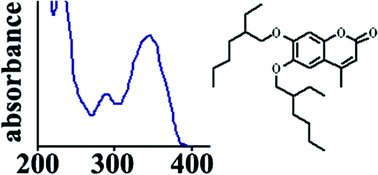UVA absorption and photostability of coumarins†
Abstract
Various substituted

* Corresponding authors
a Program of Petrochemical and Polymer Science, Faculty of Science, Chulalongkorn University, Bangkok, Thailand
b National Center of Excellence for Petroleum, Petrochemicals, and Advanced Materials (NCEPPAM), Chulalongkorn University, Bangkok, Thailand
c
Department of Chemistry, Faculty of Science, Chulalongkorn University, Bangkok, Thailand
E-mail:
psupason@chula.ac.th
Fax: +66 2 2541309
Tel: +66 2 2187634
Various substituted

 Please wait while we load your content...
Something went wrong. Try again?
Please wait while we load your content...
Something went wrong. Try again?
W. Jivaramonaikul, P. Rashatasakhon and S. Wanichwecharungruang, Photochem. Photobiol. Sci., 2010, 9, 1120 DOI: 10.1039/C0PP00057D
To request permission to reproduce material from this article, please go to the Copyright Clearance Center request page.
If you are an author contributing to an RSC publication, you do not need to request permission provided correct acknowledgement is given.
If you are the author of this article, you do not need to request permission to reproduce figures and diagrams provided correct acknowledgement is given. If you want to reproduce the whole article in a third-party publication (excluding your thesis/dissertation for which permission is not required) please go to the Copyright Clearance Center request page.
Read more about how to correctly acknowledge RSC content.
 Fetching data from CrossRef.
Fetching data from CrossRef.
This may take some time to load.
Loading related content
